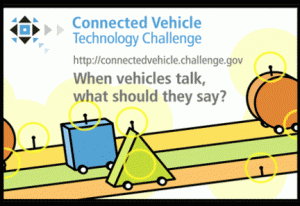 On the heels of a speech by President Obama last week touting a public-private partnership seeking to “help large fleets reduce diesel and gasoline use by incorporating electric vehicles, alternative fuels, and fuel-saving measures” including mobile applications, U.S. Chief Technology Officer Aneesh Chopra yesterday described a variety of Federal research programs aimed at deploying new and innovative information and communications technologies throughout the transportation system. In a blog entry on The White House website, Chopra and Peter Appel, Administrator of the Transportation Department’s Research and Innovative Technology Administration, wrote:
On the heels of a speech by President Obama last week touting a public-private partnership seeking to “help large fleets reduce diesel and gasoline use by incorporating electric vehicles, alternative fuels, and fuel-saving measures” including mobile applications, U.S. Chief Technology Officer Aneesh Chopra yesterday described a variety of Federal research programs aimed at deploying new and innovative information and communications technologies throughout the transportation system. In a blog entry on The White House website, Chopra and Peter Appel, Administrator of the Transportation Department’s Research and Innovative Technology Administration, wrote:
The U.S. Department of Transportation (USDOT), through the Research and Innovative Technology Administration’s Intelligent Transportation Systems (ITS) Research Program, in close partnership with the Federal Motor Carrier Safety Administration (FMCSA), has been leading research into mobile applications for fleet management, with an eye to improving transportation safety as well as reducing truck and motor coach fuel consumption and emissions. USDOT is pleased to support critical national priorities in safety, environment and economic competitiveness through our ITS research.
Already, major national trucking fleets have been using mobile wireless applications to stay safe and reduce emissions, delivering goods on time and improving the bottom line, by:
- using real-time routing to find the fastest way to a destination;
- using real-time traffic information to avoid congestion and guide just-in-time delivery;
- using advanced road weather information to avoid hazards and to find the safest route.
Increasingly, firms are working with partners in the states to use wireless transponders to transmit cargo and inspection information ahead; to avoid the stops at truck weigh and inspection stations, keeping freight moving safely and efficiently; and to plan “green routing” that will allow trucks to “stop and start” less, reducing frequent changes to engine throttling that contribute to emissions—minimizing trucking’s carbon footprint.
And, don’t forget transit bus fleets. Transit is already a great way to reduce congestion and emissions, and transit agencies are using wireless systems developed by the ITS Program (in collaboration with our partners at the Federal Transit Administration) to improve routing, to improve performance through transit signal priority, and to let customers know where and when their next transit option will be arriving.
The ITS program continues to accelerate innovation in wireless applications, providing the foundation for connected vehicles that will be able to “talk” to one another to avoid crashes and the congestion (and emissions) that result. We are especially excited about our new Applications for the Environment: Real-Time Information Synthesis (AERIS) program, to facilitate green transportation choices, and “cleaner air through smarter transportation.” We are looking forward to expanding our work in mobile wireless applications for transportation as the President’s Wireless Innovation and Infrastructure Initiative moves forward.
Chopra and Appel went on to announce another program — the Connected Vehicle Technology Challenge — which is “calling on problem solvers to share their ideas about innovative uses of … advanced wireless technology that enables vehicles to communicate.”
Check out the full post by Chopra and Appel on the OSTP Blog, as well as the various research initiatives at the intersection of computing and transportation they mention.
(Contributed by Erwin Gianchandani, CCC Director)










Trackbacks /
Pingbacks